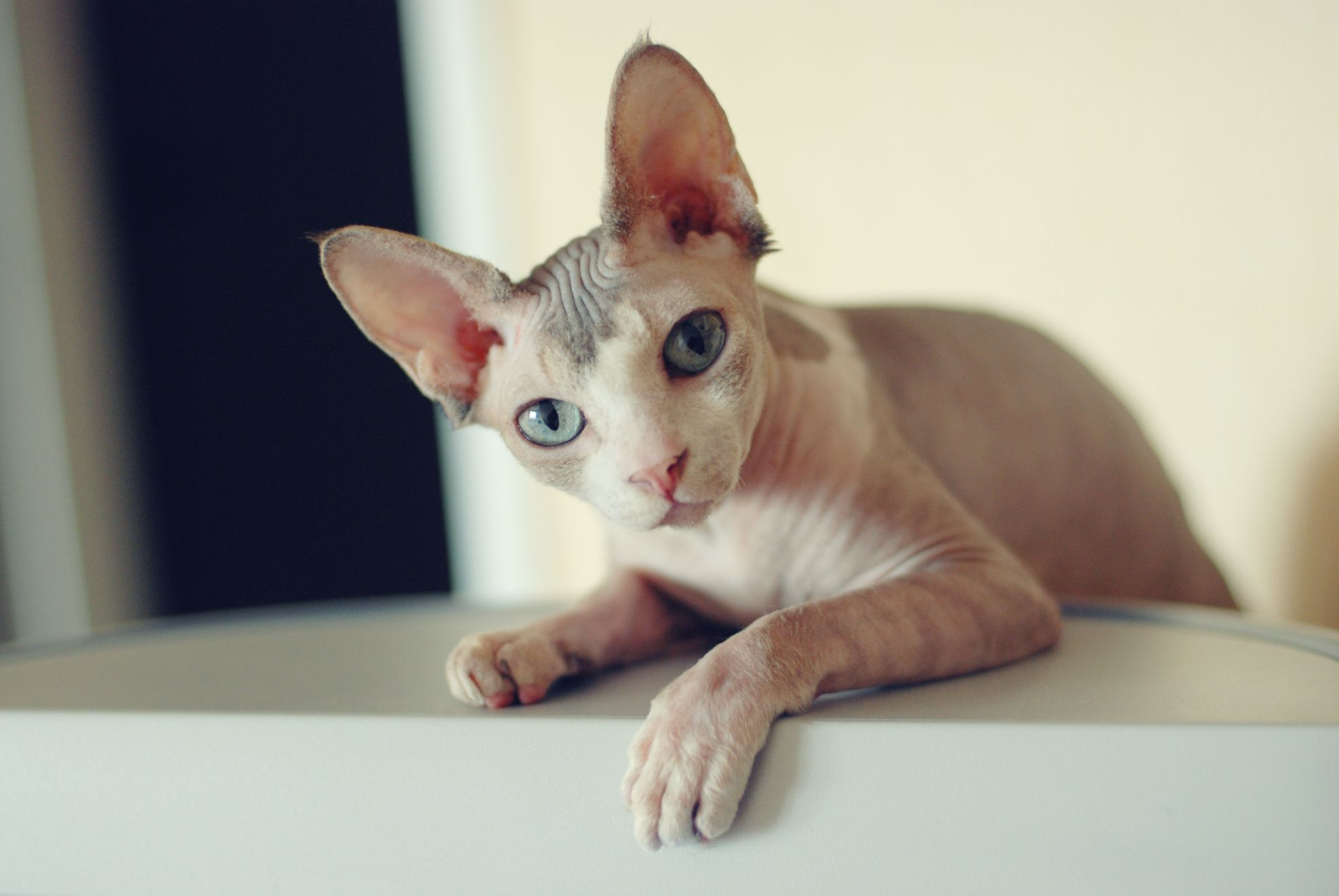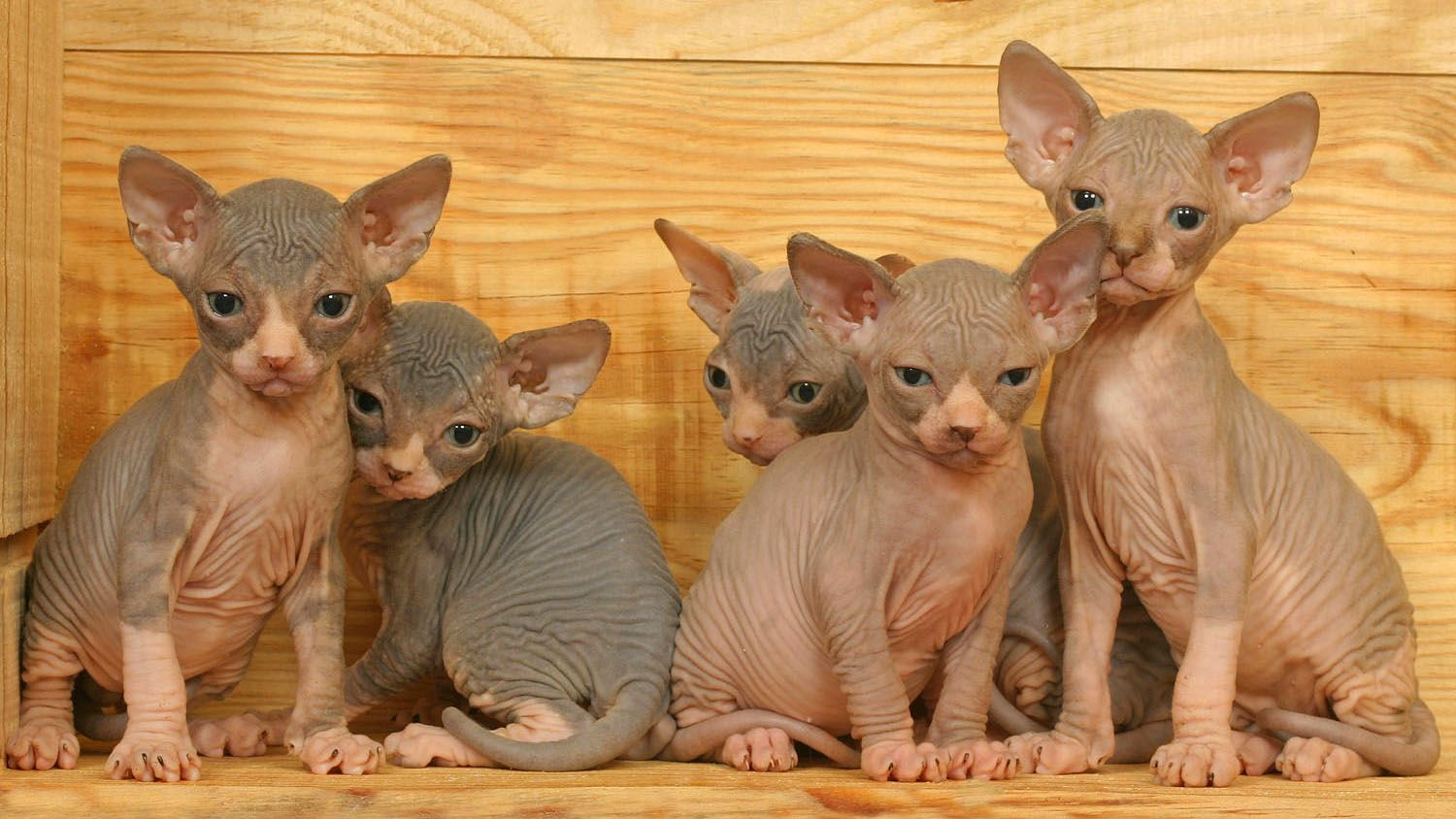Let's talk Sphynx
There is no mistaking the Sphynx cat. Unique among felines, the hairless breed is covered instead in a down-like coat flowing with sweet wrinkles. Highly personable and a mega-cuddler, lovers of the breed can’t get enough of their attentive characteristics. The Sphynx is fine if left alone but overjoyed to be with their humans, and will let you know in no uncertain terms when they need more attention.
Official name: Sphynx
Other names: Canadian Sphynx, Canadian Hairless Cat
Origins: Ontario, Canada
Grooming needs
3 out of 5Energy level
4 out of 5Vocal
3 out of 5Environment indoor or outdoor
2 out of 5Family pet
5 out of 5Compatibility with other pets
5 out of 5Can stay alone
4 out of 5
| Male | Female |
|---|---|
| Height | Height |
| 0 - 0 cm | 0 - 0 cm |
| Weight | Weight |
| 4 - 7 kg | 3 - 4 kg |
| Life Stage | |
|---|---|
| Kitten | Adult |
| 4 to 12 months | 1 to 7 years |
| Mature | Senior |
| 7 to 12 years | From 12 years |
Grooming needs
3 out of 5Energy level
4 out of 5Vocal
3 out of 5Environment indoor or outdoor
2 out of 5Family pet
5 out of 5Compatibility with other pets
5 out of 5Can stay alone
4 out of 5
| Male | Female |
|---|---|
| Height | Height |
| 0 - 0 cm | 0 - 0 cm |
| Weight | Weight |
| 4 - 7 kg | 3 - 4 kg |
| Life Stage | |
|---|---|
| Kitten | Adult |
| 4 to 12 months | 1 to 7 years |
| Mature | Senior |
| 7 to 12 years | From 12 years |
Tailored nutrition for your Sphynx

Get to know the Sphynx
All you need to know about the breed
Not all cats were created equal. The Sphynx is the most extraordinary of cats—no real coat to speak of?! —and the most typical of atypical felines. Not just good but great-natured, their doting expression shines out from lemon-shaped eyes crowned by inches-high ears. There’s no other way to put it: This is one cool cat.
Although the breed appears to be from the ancient world, they originate from the cold climes of Canada: In 1966, the first Sphynx cat was born to a domestic cat, and was nothing more than a genetic mutation. The breed has also been called by the name Canadian Hairless Cat.
The Sphynx cat temperament is divine. They are always up for a cuddle or a turn on your lap. This is a velcro-cat, for sure: both lively and affectionate. The breed loves to be held and truly craves attention—and when they don’t receive it, they will all but get in your face to ask for more. Not a huge talker, the breed is nonetheless communicative, but it’s all because they dig being part of the pack.
Now, about that coat… that fur… that covering… The Sphynx is encased in a soft, fine down-like topper that doesn’t have many matches in the animal kingdom. Think Chamois. The breed can be totally hairless as well, sporting skin and nothing else. Applying a vet-approved moisturizer or scent-free oil is necessary to protect the coat—which means weekly baths with moisturizing or baby shampoo to keep oils from mussing the furniture. The skin naturally folds over the Sphynx body.
As if all this wasn’t enough, the Sphynx cat's fur comes in a variety of chic color combinations—ranging from blue, to black tortie and white, to red and white.
And don’t they look smart? That’s because they are. Their wise gaze gives them a sort of feline one-upmanship, as if they might possess all the knowledge in the world. We’ll never know. And that is perfectly fine.

2 facts about Sphynx
1. Not a hypoallergenic breed
Despite their lack of fur, the Sphynx cat is not a hypoallergenic breed—meaning possessing a coat that makes them non-allergy-provoking to the humans in their midst.
2. A live hot water bottle
One would think a cat without fur would be cold to the touch: Not so the Sphynx. This is a cat that runs hot: The breed has a higher body temperature and burns calories faster than other felines. Your cat will still, however, need to be kept warm for optimum health.
History of the breed
One look at the Sphynx cat's unparallelled appearance and thoughts of exotic origins in the Far East come to mind. Actually, it’s just the opposite: They originate from Toronto, Canada. Not that Canada isn’t exotic, mind you. In 1966, the first known Sphynx was born to a domestic cat named Elizabeth, a unassuming black and white feline who produced a genetic mutation.
The kitten, known as Prune, was quickly bred by their owner with other hairless cats and the breed took hold. The Sphynx breed was crossed at that time with the Devon Rex, a breed emanating from England with similarly large ears and a very short coat. The hairless kittens, however, prevailed.
The Sphynx has been also called by the name Canadian Hairless Cat, but eventually acquired the present name because their appearance resembles cat-like images found in ancient Egypt.
From head to tail
Physical characteristics of Sphynx
1.Ears
2.Head
3.Body
4.Tail
5.Coat

Things to look out for
From specific breed traits to a general health overview, here are some interesting facts about your Sphynx
They can be prone to cardiac problems
When properly bred, Sphynx cats are healthy and lead a robust life. The breed does, however, run the risk of hypertrophic cardiomyopathy, a cardiac condition that can be hereditary, characterized by a thickening of the walls of the heart. It sounds dangerous, but can be controlled by medication if the condition arises. Make regular visits to your veterinarian to rule out any possibilities.
How hairless are they?
The interesting part about the hairlessness of the Sphynx cat is that there are different degrees of hairlessness. Some cats have the feel of suede, whereas others have a smooth, buttery sensation to their coat. Certain Sphynx possess slightly thicker patches of fur on their nose and ears or their toes and tail. The Sphynx’s covering is like a silky down, but in no way is there no hair at all.
Why the big belly?
The Sphynx anatomy is such that they are sound all around, even though they look fairly delicate. Perhaps it’s the absence of fur—but they are in reality hardy cats, and that includes their mid-region. Often called a pot belly, their tummy is firm and taut, as if they’ve just finished a big bowl of kibble. What to feed a Sphynx cat, then? Ironically, because of their lack of hair, they should eat more than other cats who would normally have enough plush covering to keep themselves warm. Because of this, breeders greenlight eating kibble at will—food left out to snack on.
Your vet may also discuss your Sphynx cat’s weight management as a preventive measure. These simple tools can help you stay on top of potential problems.

Caring for your Sphynx
Grooming, training and exercise tips
That lithe body looks trim and slim. Sphynx are in fact born athletes, and have a natural propensity to climb—especially to things way out of their reach. They are huge fans of play, not a cat to sit around on the couch for hours. Their need for movement makes them even more fascinating, and keeps them in shape to boot. The breed benefits from a high metabolism—which is just as well, considering their big appetite. A word of caution: Whereas many cats get their exercise outside, this is one that should be kept indoors and out of the sun due to their delicate skin.
The Sphynx cat fur may be less plentiful, but that doesn’t mean they don’t need grooming—it just comes in a different form. Their down-like coat requires almost more attention than their fellow furry felines. Protect it best by slathering unscented oil or moisturizer on them frequently—much like humans do to their own skin to make it soft and silky. For the best care of your Sphynx cat, weekly baths should also be had with a moisturizing pet-safe shampoo to keep oil from getting on household items. The Sphynx’ skin falls in delicate folds over their body, and needs attention when bathing to keep it clean; in a pinch, baby wipes can help.
Known as a very affectionate breed, the Sphynx personality is an enthusiastic one, eager to please and to learn. This cat exhibits a high level of intelligence and a huge amount of energy, traits that contribute to their taking discipline well. The Sphynx is extremely loyal, so the cat-human bond is one they enjoy and respect. They respond best to training that includes positive reinforcement.
That lithe body looks trim and slim. Sphynx are in fact born athletes, and have a natural propensity to climb—especially to things way out of their reach. They are huge fans of play, not a cat to sit around on the couch for hours. Their need for movement makes them even more fascinating, and keeps them in shape to boot. The breed benefits from a high metabolism—which is just as well, considering their big appetite. A word of caution: Whereas many cats get their exercise outside, this is one that should be kept indoors and out of the sun due to their delicate skin.
The Sphynx cat fur may be less plentiful, but that doesn’t mean they don’t need grooming—it just comes in a different form. Their down-like coat requires almost more attention than their fellow furry felines. Protect it best by slathering unscented oil or moisturizer on them frequently—much like humans do to their own skin to make it soft and silky. For the best care of your Sphynx cat, weekly baths should also be had with a moisturizing pet-safe shampoo to keep oil from getting on household items. The Sphynx’ skin falls in delicate folds over their body, and needs attention when bathing to keep it clean; in a pinch, baby wipes can help.
Known as a very affectionate breed, the Sphynx personality is an enthusiastic one, eager to please and to learn. This cat exhibits a high level of intelligence and a huge amount of energy, traits that contribute to their taking discipline well. The Sphynx is extremely loyal, so the cat-human bond is one they enjoy and respect. They respond best to training that includes positive reinforcement.
All about Sphynx
From all reports by Sphynx fans, the breed makes for a hugely enjoyable addition to the family. Active, affectionate, and cuddly are just some of the adjectives describing this one-of-a-kind cat. The Sphynx personality is one that requires a good dose of companionship, and isn’t terribly pleased if left alone. They are known to be terrific with children and other animals.
The breed has—you guessed it—the potential for skin maladies and sunburns. The Sphynx lacks melanin in their skin, the property in pigment that guards against the absorption of harmful UV rays. Keeping kitty out of the sunlight is best but if this is hard, talk to your vet about using a pet-safe sunscreen. Regular bathing should be done to steer clear of potential skin problems. The breed also runs the risk of hypertrophic cardiomyopathy, a hereditary cardiac condition. Regular vet visits help keep your Sphynx cat healthy.
Read more on this topic
Sources
- Veterinary Centers of America https://vcahospitals.com/
- Royal Canin Cat Encyclopedia. Ed 2010 and 2020
- Banfield Pet Hospital https://www.banfield.com/
- Royal Canin BHN Product Book
Like & share this page